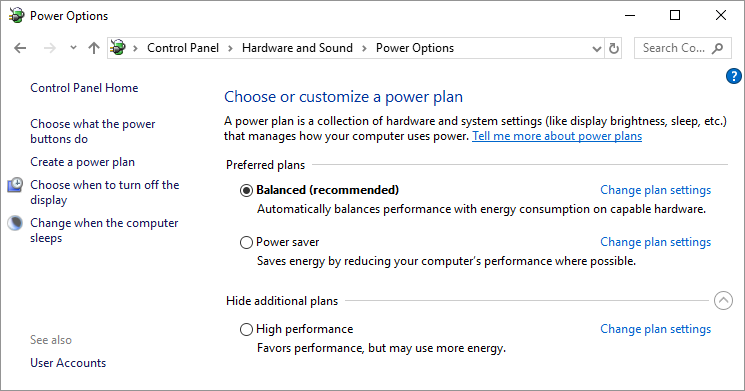Choosing a Power Management Plan
It's obvious that your computer uses power; it has to in order to operate properly. You can, however, minimize the amount of power your computer uses by changing Windows' power settings. You can access those settings in this manner:
- Display the Control Panel.
- At the left side of the screen click the Hardware and Sound heading. Windows displays the Hardware and Sound screen.
- Under the category of Power Options, click the Change Power-Saving Settings option. Windows displays the Power Options screen. (See Figure 1.)

Figure 1. The Power Options screen.
- Pick one of the power management plans available on the screen.
Most modern computers allow Windows to control both the computer itself (including the hard drive) and the display monitor. These components can be set to automatically "turn off" after varying amounts of inactivity. Windows offers three power management plans that you can select in step 4:
- Balanced. This is typically the plan recommended for desktop systems. It turns off the display monitor after 10 minutes and puts the computer to sleep after 30.
- Power Saver. This plan works great for laptop and mobile systems. It turns the display off after 5 minutes and puts the computer to sleep after 15.
- High Performance. This plan is designed for systems that may require a lot of unattended computational time, where you don't really want the computer to pause what it is working on. It turns off the display monitor after 20 minutes and never puts the computer to sleep.

 This tip (10716) applies to Windows 7 and 10.
This tip (10716) applies to Windows 7 and 10.
Author Bio
Allen Wyatt
With more than 50 non-fiction books and numerous magazine articles to his credit, Allen Wyatt is an internationally recognized author. He is president of Sharon Parq Associates, a computer and publishing services company. Learn more about Allen...
Duplicating Drawing Objects
Need to duplicate a drawing object? It's easy to do if you use the same editing techniques you are already familiar with.
Discover More
One Shortcut for Two Macros
Excel allows you to assign shortcut keys to macros. Given two different workbooks each containing different macros, it is ...
Discover More
Merging and Printing
When you merge information into a document, Word provides two different ways you can create your output. Here's an ...
Discover More
Connecting a Bluetooth Keyboard
Bluetooth allows electronic devices to connect wirelessly. Discover how easy it is to connect a Bluetooth keyboard to ...
Discover More
Determining If a Drive Should be Defragmented
Disk fragmentation is one of those things which, if severe, can adversely affect your system's performance. This tip ...
Discover More
Using Powercfg to Change the Active Power Scheme
You can easily change which power scheme is active by using the SetActive switch. This tip shows you how.
Discover More

![]()
![]() This tip (10716) applies to Windows 7 and 10.
This tip (10716) applies to Windows 7 and 10.
Comments